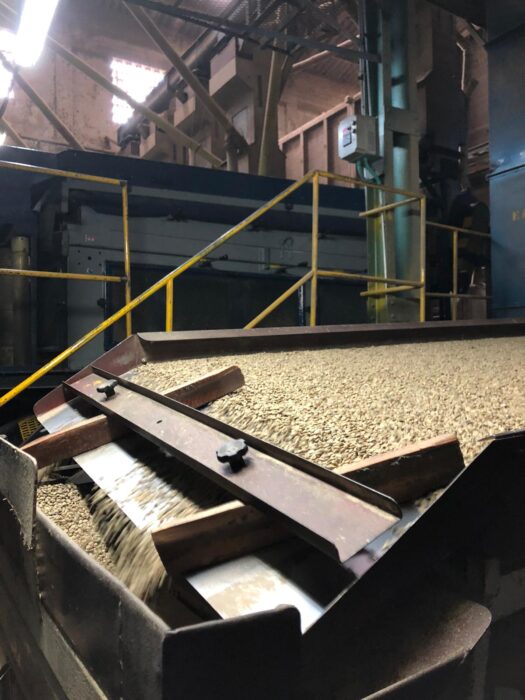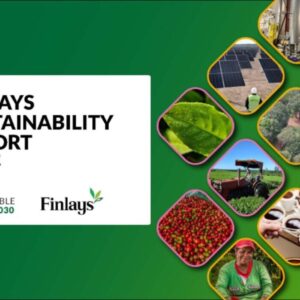Brazilian Naturals exports fall for seven consecutive months in CY 2024/25

Image credit: Vanessa L Facenda
The International Coffee Organization (ICO) revealed in its October Green Coffee Report that green bean exports of the Brazilian Naturals decreased by 21.9% in September 2025 to 3.19 million bags from 4.09 million bags in September 2024, marking the seventh consecutive month of negative growth, and ninth in total in coffee year 2024/25. Brazil was the main driver of the downturn, with its exports having decreased by 11.7% to 32.22 million bags in coffee year 2024/25 from CY 2023/24. Despite this, the ICO reports that Brazilian Naturals have been on a sustained upward longer-term trend.
Green Coffee Price
The ICO Composite Indicator Price (I-CIP) averaged 326.38 US cents/lb in October 2025, a 0.5% increase from September 2025. The I-CIP posted a median value of 325.52 US cents/lb and fluctuated between 314.68 and 344.77 US cents/lb. The I-CIP remained stable, moving sideways throughout the month of October. The October 2025 I-CIP is above the October 2024 I-CIP by 30.3%, with the 12-month rolling average at 312.93 US cents/lb.
The Colombian Milds’ and Other Milds’ prices moved in opposite directions, with variations of -0.1% and 0.9% compared to September 2025, and averages of 403.25 and 403.79 US cents/lb, respectively, in October 2025. The Brazilian Naturals shrank 0.4% to 373.47 US cents/lb in October 2025. The Robustas expanded 2.0% to 215.06 US cents/lb. The prices at the London Intercontinental Commodity Exchange (ICE) market increased by 2.3% to 202.16 US cents/lb, while the New York ICE market declined by 0.1% to 366.00 US cents/lb in October 2025.
The I-CIP remained range-bound stable throughout October 2025, with bullish and bearish factors offsetting each other:
• A potential reduction of tariffs applied on Brazilian coffee by the United States. US President Donald Trump predicted that the two nations could “pretty quickly” strike a trade deal as he met with counterpart President Luiz Inacio Lula da Silva, stating that “there’s no reason for having any kind of conflict” between Brazil and the US, and that he was hopeful he soon could announce “good news.”
• A widespread sentiment of consumption growth rates slowing down:
• The price in BRL of a supermarket basket containing coffee in Brazil rose significantly due to the high international prices, quoted in USD, in addition to high inflation within key coffee consuming-producing countries.
• Signs of weakening US consumer spending, with vehicle repossessions rising 12% year on year to 1.7 million – the highest level since the 2009 crash.
However, on the flip side, the following bullish price factors continued to positively influence the I-CIP:
• Central American supply is keeping positive pressure on prices, due to hurricane Melissa, low rain in key Brazilian regions, and labour shortages.
• Structural container shortages at origin, logistics delays with longer transshipment times, and Suez Canal restrictions have kept more coffee ‘on the water’, reducing availability at destination.
• The structural backwardation (a market situation where immediate delivery is higher than for coffee available for future delivery) remains in the ICE markets, as supply shortfalls make coffee more expensive to purchase now than for future delivery.
• Headlines about crop losses in Vietnam, as well as in the Philippines and Cambodia, due to typhoon Kalmaegi.
The Colombian Milds–Other Milds differential shifted from 3.56 to -0.54 US cents/lb between September and October 2025. The Colombian Milds–Brazilian Naturals differential grew by 3.2% to 29.78 US cents/lb, whilst the Colombian Milds–Robustas differential also retracted by 2.5% from September to October 2025, averaging 188.19 US cents/lb. Meanwhile, the Other Milds–Brazilian Naturals and Other Milds–Robustas differentials moved by 19.8% and -0.3% to 30.32 and 188.73 US cents/lb, respectively. The Brazilian Naturals–Robustas differential retracted by 3.4%, averaging 158.41 US cents/lb in October 2025.
The arbitrage between the London and New York futures markets contracted by 2.9% to 163.84 US cents/lb in October 2025.
The intra-day volatility of the I-CIP climbed by 2.1 percentage points compared to September 2025, averaging 15.9% in October 2025. The volatility of the Colombian Milds and Other Milds followed the same trend, at 16.0% and 16.1%, respectively. Meanwhile, the Brazilian Naturals volatility rose by 2.4 percentage points, month-on-month, to 17.1% in October 2025. The Robustas’ volatility also increased to 15.6% from 15.0% in September 2025. At the New York and London futures markets, the volatilities were at 18.1% and 16.7%, respectively, in October 2025, up by 2.9 and 0.5 percentage points compared to September 2025.
The London certified stocks of Robusta coffee decreased by 6.2% from September to October 2025, closing the month at 1.01 million bags. US certified stocks of Arabica coffee followed the same trend, shrinking to 0.47 million 60-kg bags, a 24.2% decrease versus September 2025.
Exports by Coffee Groups – Green Beans
In September 2025, global green bean exports totalled 9.94 million bags, as compared with 9.96 million bags in September 2024, down 0.2%. This is the sixth month of negative growth in coffee year 2024/25, with the full-year volume for total green bean exports down 0.8% at 121.26 million bags, as compared with 122.21 million bags in coffee year 2023/24.
Exports of the Colombian Milds increased by 7.0% in September 2025 to 1.07 million bags from 1.00 million bags in September 2024. This is the 24th consecutive month of positive growth, resulting in an increase in exports of the Colombian Milds of 11.5% in coffee year 2024/25 to 13.9 million bags, as compared with 12.23 million bags in coffee year 2023/24.
For the full year, Colombia, the world’s largest producer and exporter of the Colombian Milds, was the main driver of the group’s exports, with its volume up 13.0% to 12.39 million bags in coffee year 2024/25 from 10.97 million bags in coffee year 2023/24. With Colombia exporting an average of 96% of its coffee production, the origin’s latest export success reflects a sharp increase in output — up 16.5% to 14.87 million bags in coffee year 2024/25.
Shipments of the Other Milds increased by 6.1% in September 2025 to 2.0 million bags from 1.89 million bags in the same period in 2024. The total volume for coffee year 2024/25 is 23.7 million bags as compared with 23.07 million bags in coffee year 2023/24, up 2.7%. There were mixed dynamics among the origins belonging to this group, with Ethiopia, Mexico and Nicaragua being the main positive drivers, with their combined exports making a net gain of 1.61 million bags compared to coffee year 2023/24. Guatemala, Papua New Guinea and Peru were the main negative drivers, with their combined exports down by a net 1.38 million bags.
Green bean exports of the Brazilian Naturals decreased by 21.9% in September 2025 to 3.19 million bags from 4.09 million bags in September 2024. This is the seventh consecutive month of negative growth, and ninth in total in coffee year 2024/25. As a result, the exports of the Brazilian Naturals fell to 39.31 million bags in coffee year 2024/25 from 42.5 million bags in coffee year 2023/24, down 7.6%. Brazil was the main driver of the downturn, with its exports having decreased by 11.7% to 32.22 million bags in coffee year 2024/25 from 36.48 million in coffee year 2023/24. The origin’s sharp downturns appear to be linked to the strong cyclical nature of Brazil’s Arabica coffee production and a base effect.
Coffee year 2023/24 was an ‘on-year’ for Brazil’s exports of the Brazilian Naturals, which were up 21.7% for the year, also the highest export level recorded. The effect of Brazil’s downturn on the group as whole was mitigated mainly by the strong performance of Ethiopia, whose exports of the Brazilian Naturals were up 24.4% to 4.91 million bags in coffee year 2024/25, a net year-on-year gain of 0.96 million bags. The double-digit result of Ethiopia’s campaign for coffee year 2024/25 appears to be linked to the increase in local production, estimated to be up 11.2% to 9.91 million bags, and to a higher-than-usual volume of stocks being released, stimulated by the high price of the Brazilian Naturals, which averaged 361.6 US cents/lb in coffee year 2024/25, up 58.9% year-on-year.
Green bean exports of the Robustas were up 23.0% to 3.67 million bags in September 2025 from 2.99 million bags in September 2024. This marks the fourth month of negative growth in coffee year 2024/25, with full-year exports of the Robustas declining by 0.02% to 44.35 million bags, compared to 44.36 million bags in coffee year 2023/24. The overall flat growth rate of the group masked rather strong inter-origin variations during coffee year 2024/25. Brazil’s Robusta exports fell 47.8% to 4.89 million bags from 9.37 million bags in coffee year 2023/24. This double-digit downturn was expected, given that last year’s export volume was unprecedented – almost three times the average of the five preceding coffee years (2018/19–2022/23) – and extraordinarily high because of a vacuum within the global Robusta market caused by poor harvests among the other world’s leading Robusta producers.
In coffee year 2023/24, Indonesia and Vietnam’s Robusta exports fell by 37.0% and 15.7%, respectively, a net loss of 5.31 million bags. These sharp downturns were due to equally strong decreases in their Robusta harvests, which fell by an estimated 23.7% and 12.8%, respectively, a combined net loss of 6.08 million bags. In coffee year 2024/25, the combined Robusta outputs of Indonesia and Vietnam increased by 11.0% (year on-year) with a net gain of 3.65 million bags, and exports increased by 132.6% and 31.3%, respectively, over the same periods, with a combined net gain of 5.4 million bags. The resurgence of these two Asian origins consequently crowded out Brazil from the Robustas market.
The total Arabicas exports decreased to 76.91 million bags in coffee year 2024/25, down 1.2% from 77.85 million bags last coffee year. As a result, the Arabicas’ share of the total green beans exports in coffee year 2024/25 fell to 63.4% from 63.7% in coffee year 2023/24. Since coffee year 2016/17, the share of the Arabicas has been fluctuating around a mean of 63.4%.
In coffee year 2024/25, the share of the Brazilian Naturals in total green bean exports fell to 32.4% from 34.8% in coffee year 2023/24, as the other three groups gained ground. Nonetheless, the Brazilian Naturals have been on a sustained upward longer-term trend, increasing their market share to an average 33.0% in coffee years 2020/21–2024/25, up from 29.9% in coffee years 2000/01–2009/10. The other two Arabicas groups also saw their market shares fall, with the Colombian Milds and Other Milds losing 2.1 and 3.2 percentage points, respectively, between the average for coffee years 2000/01–2009/10 and coffee years 2020/21–2024/25.
Exports by Regions – All Forms of Coffee
Global exports of all forms of coffee decreased by 2.8% to 11.00 million bags in September 2025 as compared with 11.31 million bags in September 2024. This is the sixth month of negative growth in coffee year 2024/25, leading to a 0.3% decline in full-year exports to 138.66 million bags, as compared with 139.01 million bags in coffee year 2023/24. South America was the driver of the overall downturn, overwhelming the positive expansions of the remaining three regions.
Exports of all forms of coffee from Asia & Oceania were up 29.3% to 3.05 million bags in September 2025 from 2.36 million bags in September 2024. For coffee year 2024/25, exports increased to 44.45 million bags from 40.73 million bags last coffee year, a 9.1% rise. The expansion for the year was mainly driven by Indonesia and Vietnam, whose exports increased 46.0% and 7.1% to 9.77 million bags and 26.86 million bags, respectively. The upturns of the two origins were mainly due to improved harvests in coffee year 2024/25, reversing the situation of the previous coffee year. For coffee year 2024/25, Indonesia and Vietnam’s total coffee production are estimated at 11.27 million and 29.19 million bags, respectively, up 22.3% and 9.0%.
Exports of all forms of coffee from Africa increased by 3.2% in September 2025 to 1.49 million bags from 1.45 million bags in September 2024. For coffee year 2024/25, exports increased to 19.69 million bags from 16.6 million bags in coffee year 2023/24, a 18.6% jump. Ethiopia and Uganda were the main drivers behind the region’s positive expansion in coffee year 2024/25, with their exports increasing by 27.3% and 29.6%, respectively, to 7.37 and 8.26 million bags. Good harvests, associated with high international coffee prices and the release of higher-than-usual stock volumes, explain this double-digit growth. Ethiopia’s harvest for coffee year 2024/25 is estimated at 9.91 million bags, while Uganda’s stands 7.05 million bags.
In September 2025, South America’s exports of all forms of coffee decreased by 13.9% to 5.67 million bags from 6.58 million bags in September 2024. This is the tenth consecutive month of negative growth for the region, following a 16-month streak of positive growth. As a result, South American exports in coffee year 2024/25 were down by 12.3% to 58.94 million bags from 67.22 million bags in coffee year 2023/24. The downturn was mainly due to Brazil, whose exports fell by 17.9% to 41.11 million bags from 50.1 million bags in coffee year 2023/24. The origin’s downturn and its magnitude were due to a base effect, market vacuum and its production cycle.
In coffee year 2023/24, Brazil’s Robusta exports were up 135.4% due to the international Robusta vacuum brought about by a curtailed supply from the two top Robusta exporters, Indonesia and Vietnam. Meanwhile, the Brazilian Naturals were up 20.7%, reflecting the 13.8% increase (crop year) in the Arabica harvest during the “on-year” of the biennial production cycle. In coffee year 2024/25, the internal Robusta vacuum disappeared, and the Arabicas found themselves in their ‘off-year’ of the biennial production cycle. Logistics issues at the main coffee exporting port of Santos were an additional variable affecting the magnitude of downturn for Brazil and South America.
In September 2025, exports of all forms of coffee from Mexico & Central America decreased by 14.6% to 0.79 million bags as compared with 0.93 million bags in September 2024. This is the fourth month of downturn for the region in coffee year 2024/25, but with the full year exports volume increasing to 15.58 million bags from 14.46 million bags last coffee year, up 7.7%. Mexico and Nicaragua were the main drivers of the upturn of the region, with their exports up 24.8% and 17.1%, respectively.
As a result, South America saw its market share fall to 42.5% in coffee year 2024/25 from 48.4% in coffee year 2023/24. However, it remains the largest exporter by regions. The remaining three regions saw their shares increase, with Asia & Oceania increasing its market share by 2.8 percentage points to 32.1% from 29.3% in coffee year 2023/24. Similarly, Africa gained 2.3 percentage points in market share in coffee year 2024/25.
Moreover, during 2020/21–2024/25, an emerging upward trend became evident, with the region’s average market share rising to 11.8%, compared to 10.0% in 2010/11–2019/20. The Caribbean, Central America and Mexico, on the other hand, are on a downward trajectory, with their average market share down to 11.7% in 2020/21–2024/25, making it now the smallest exporting region.
Exports of Coffee by Forms Exports Trends by Regions
Total exports of soluble coffee decreased by 21.0% in September 2025 to 1.01 million bags from 1.28 million bags in September 2024. Full year exports were up 5.0% to 16.72 million bags in coffee year 2024/25 from 15.92 million bags in coffee year 2023/24.
Exports of roasted beans were down 29.4% in September 2025, reaching 0.05 million bags, compared to 0.07 million bags in September 2024. Full year exports were down 22.9% to 0.68 million bags in coffee year 2024/25 from 0.88 million bags in coffee year 2023/24.
As a result, the share of green beans was down at 87.5% in coffee year 2024/25 from 87.9% in coffee year 2023/24. Moving in an opposite direction relative to all forms of coffee, the share of soluble coffee increased to 12.1% from 11.5%.
For the full report, visit ico.org.






